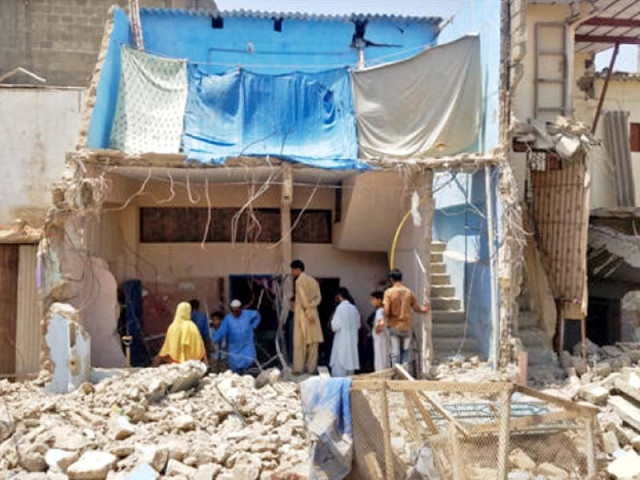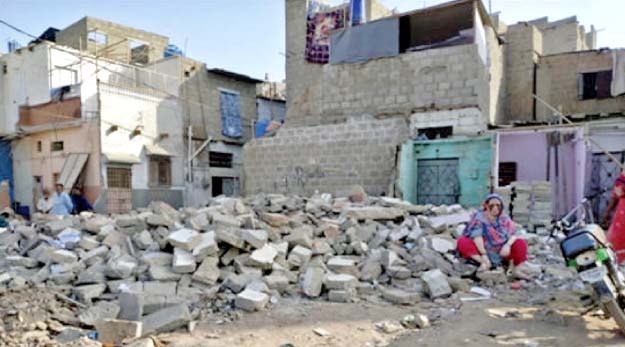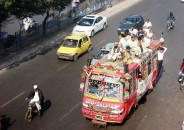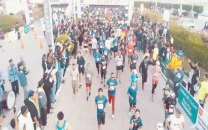A marred Eid for residents living along the KCR tracks
As the city administration scrambles to fulfil the SC’s orders, hundreds of residents are rendered homeless

Houses demolished as part of the operation in Mujahid Colony, Nazimabad. PHOTO: KARACHI URBAN LAB FILES
Zulekha, a resident of Mujahid Colony, located in UC-09 Nazimabad, Karachi, is amongst the hundreds of citizens who have been affected by the current “anti-encroachment drive” initiated as a result of the orders of the Supreme Court issued on 9th May 2019. As per the directives of the SC, all encroachments along the Karachi Circular Railway (KCR) track were to be cleared within two weeks. What has ensued, however, is that the administration has missed the other part of the order, which provided for the resettlement of the affected persons.
With temperatures rising to 40 degrees and residents observing fasts in the month of Ramzan, people living in the demolished settlements question the urgency of the operation that could have been carried out after Eid. Given that municipal authorities did not issue notices prior to the demolition, residents have been left scrambling to find alternative arrangements; while many continue living in the debris of their demolished houses. The settlements most severely affected by the ongoing operation include Gharibabad, Quaid-e-Azam Colony, Wahid Colony, Mujahid Colony, Moosa Colony and settlement located around Gilani station and Urdu College; most of which are located in District East of Karachi.
But this is not the first anti-encroachment drive experienced within a year by the residents of many of these settlements. Following an SC order dated November 17, 2018, demolitions took place in different parts of the city including Gharibabad and adjacent Quaid-e-Azam Colony. On December 11, a number of shops and residential units were demolished under the pretext of clearing the land for Karachi Circular Railways Revival project.
 Residents try to salvage what remains of their houses, exerting themselves in the blazing heat while fasting. PHOTO: KUL FILES
Residents try to salvage what remains of their houses, exerting themselves in the blazing heat while fasting. PHOTO: KUL FILESHowever, no decision had been reached on the railway’s Right Of Way (ROW), resulting in a haphazard demolition process with selective destruction. The residents breathed a sigh of relief as the Supreme Court provided a stay for all residential units, giving the impression that the remaining houses in the settlement were now safe from demolition; but this soon proved wrong.
This threat of eviction and displacement has been looming far beyond a few months; to a point in time 15 years ago, when the KCR’s revival was first announced. In 2003, the Federal Government announced that the KCR’s revival was going to take place. Subsequently, in 2009, an extensive survey was initiated by the Japan International Cooperation Agency (JICA), which was assigned the responsibility for the project’s execution. The JICA’s two-year long survey conducted across the 28 affected settlements, gave way to an Environmental Impact Assessment (EIA) report and a Resettlement Action Plan (RAP). The survey revealed that 4,653 households with nearly 45,000 people were going to be impacted; but JICA also put forward a comprehensive compensation and resettlement plan for the ‘project affected persons’ or PAPs. These PAPs were awarded certificates from JICA, with official stamps of the Federal Government and a compensation plan that included construction of 80 square yard houses in Jumma Goth together with monetary compensation of Rs. 50,000/- per household. However soon after, JICA pulled itself out of the project and while the government continues to revert to the EIA report, the contents of the RAP have been entirely disregarded.
 A female resident in Gharibabad, Liaquatabad sits atop the rubble of her house. PHOTO: AURATHAQ (TWITTER)
A female resident in Gharibabad, Liaquatabad sits atop the rubble of her house. PHOTO: AURATHAQ (TWITTER)“My house was here when the KCR was operational in 1970s. My house was here when it stopped in 1999; I have not extended a foot from its original boundaries, how then has my house suddenly become illegal? How is it suddenly going to hamper the train from running?” says 74 year old Khalid, who has been living in Mujahid colony since he was seven years old.
In addition to the demolition of their only shelter in the city, the electricity and gas has also been cut off in the entire settlement for up to 10 days, as claimed by some residents. The part of the demolished structures that remain standing at present are unfit for inhabitation; with steel rods exposed, staircases half broken and blocks of concrete hanging precariously in the aftermath of the demolition process. The residents of these half-destroyed dwelling are one step away from another disaster.
The justification given for these demolitions by the municipal authorities is that the houses and residents have no legal standing and have forcefully occupied government land. However, the fact that these settlements now exist for over fifty years, with a third generation living in these dwellings, it is hard to believe that the authorities were unaware of their existence, or that the settlements emerged without government officials’ assistance. Infrastructural facilities including electricity, gas and water have been provided to these communities with the assistance and intervention of political parties, who perceive these settlements as hefty vote banks.
A large number of residents recently staged a protest at the Karachi Press Club. The protesters included women and children whose houses have been demolished as well as those who can see the impending threat of demolition. However, the height of misery was that the same time when this protest was being registered, bulldozers arrived in Wahid Colony, Nazimabad, along with a large contingent of police.
The affectees have been demanding resettlement in exchange for their demolished houses, but at the same time expressing their support for the KCR project. The residents’ demands are not unreasonable; after all the Supreme Court has also emphasized the resettlement of all residents and shopkeepers affected by the anti-encroachment operation. Instead, the federal and municipal authorities are selectively implementing the Supreme Court order, a process that is rendering people homeless and that too on the eve of religious festivities when families expect to find joy in the comfort of their homes.
The author is a Research Associate at the Karachi Urban Lab @ IBA
Published in The Express Tribune, June 5th, 2019.



















COMMENTS
Comments are moderated and generally will be posted if they are on-topic and not abusive.
For more information, please see our Comments FAQ